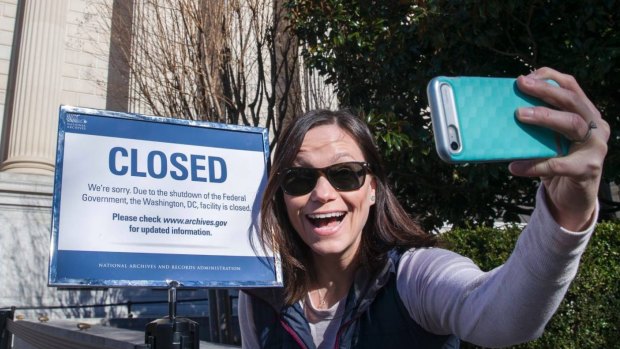This was published 5 years ago
Tourism hit as US shutdown impacts national parks, historic sites

Jamie Parrish, from Minneapolis, takes a selfie in front of the closed sign at the National Archives, in Washington.Credit: AP
The huddled masses are still able to visit the Statue of Liberty. The Grand Canyon is open for business. The US government says other national parks "will remain as accessible as possible".
Tourists trekking to parks and historic sites across the US on Saturday saw a mix of impacts from the federal government's second shutdown in less than a year.
Some attractions are staying open thanks to funding from states and charitable groups.
At some parks, you're welcome to take a hike - but you're largely on your own. At others, like the closed Gettysburg National Military Park in Pennsylvania, you're out of luck.
Utah's state government is paying to staff the visitor centres at Arches, Bryce Canyon and Zion national parks.
Arizona is ponying up to keep trails, shuttles and restrooms open at the Grand Canyon.
New York is footing the bill for the Statue of Liberty and Ellis Island for the third time in five years.
"Many travellers have planned their visit for months in advance and have travelled from all over the world to be here," said Utah Governor Gary Herbert.
"We want them to return home with memories of magnificent vistas and welcoming people, not locked doors."
The shutdown is affecting nine of the 15 cabinet-level departments, including Interior, which runs national parks, and Agriculture, which runs national forests. About 16,000 National Park Service employees - 80 per cent of the agency's workforce - are being furloughed.
At Acadia National Park in Maine, austerity measures include closing some bathrooms, curbing rubbish collection and cutting back on snowploughing. A lack of ploughing could also hinder access to Crater Lake in Oregon, Mount Rainier in Washington and other parks normally inundated with snow this time of year.
Hotels, restaurants, stores and petrol stations at Yosemite National Park in California remain open and seem unaffected by the shutdown, which has cancelled some programs, closed visitor centres and left campgrounds unstaffed.
At Pearl Harbor in Hawaii, nonprofit organisations are teaming up to keep the visitor centre open at the government-run USS Arizona Memorial. The memorial itself is closed until March for repairs to the loading dock, but visitors are still being taken on a narrated harbour tour of Battleship Row and the surrounding area.
Navy sailors operating the tour boats aren't affected by the shutdown.
At the Statue of Liberty and Ellis Island, it was business as usual after New York Governor Andrew Cuomo said the state would fund operations, as it did when the federal government shut down in 2013 and 2018.
In Arizona, Governor. Doug Ducey activated the state's Grand Canyon Protection Plan, which calls for the state to underwrite the cost of public safety and basic services at the desert treasure. Arizona developed the plan after it stepped in to fund operations during the last shutdown, 11 months ago.
"Regardless of what happens in Washington, the Grand Canyon will not close on our watch," said Ducey.
AP
See also: Warning to Australian travellers as US changes entry rules
Sign up for the Traveller newsletter
The latest travel news, tips and inspiration delivered to your inbox. Sign up now.